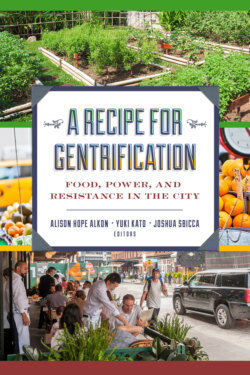Читать книгу A Recipe for Gentrification - Группа авторов - Страница 8
На сайте Литреса книга снята с продажи.
The Landscape to Come
ОглавлениеTaken together, the chapters in this volume argue that food and gentrification are deeply entangled, and that examining food retail and food practices is critical to understanding urban development. In part I, “Dining Downtown,” three chapters investigate the roles of food businesses in upscaling cities and attracting wealthy residents. First, Pascale Joassart-Marcelli and Fernando J. Bosco examine how changing dining options add value to two San Diego neighborhoods in different stages of gentrification, highlighting the cultural politics of taste in what is often theorized as an economic process. Similarly, Nina Martin’s chapter draws on examples from Durham, North Carolina to illustrate the role of “savior entrepreneurs,” restaurateurs who act as small-scale developers, in buying and refurbishing downtown buildings and helping to rebrand this post-industrial city as hip and creative. In the final chapter in this section, Eric Sarmiento dissects the emerging local food movement in Oklahoma City, arguing that in orienting their work toward the city’s growing “creative class,” they redefined local food as a luxury good rather than a product that could embody environmental sustainability and social justice.
Part II, “Ripe for Growth,” examines urban agriculture’s role in both signaling and responding to a city’s readiness for development. In chapters 4 and 5, Joshua Sbicca, Pamela Arnette Broom, and Yuki Kato describe how community-based urban agriculture projects that emerged from economic and ecological crises have weathered the ensuing land booms. First, Sbicca investigates how the city of Denver’s official support for urban agriculture in the wake of the Great Recession, in tandem with urban farmers growing food in up-and-coming neighborhoods, became an “urban agriculture fix” fostering increased land values and green gentrification. Following, the authors draw on Broom’s experience as a leader in New Orleans’ urban agriculture movement to show how gardens drew in new residents, creating both alliances and tensions with long-term residents and gardeners. In the subsequent chapter, Emily Becker and Nathan McClintock investigate how gentrification affects the meaning of community in a community orchard in Portland with an intent to serve long-term residents. In contrast, Charlotte Glennie’s chapter demonstrates the power of racially and class privileged community gardeners in Seattle to solidify their own land tenure by convincing urban boosters that their gardens are an important amenity for new residents.
Parts III and IV delve into various community responses to gentrification. Part III describes what we call “Uneven Alliances” between middle-class food activists and long-term community members. First, Michelle Glowa and Antonio Roman-Alcalá investigate how the organizations that comprise the San Francisco Urban Agriculture Alliance negotiate ethnoracial and economic differences in the context of gentrification. Next, Zachary Hyde critically analyzes the role of community-minded social entrepreneurs who develop “ethical” restaurants in Vancouver’s Downtown Eastside, arguing that while they may intend to act as social preservationists, they co-opt community-based dissent and resistance to gentrification. In contrast, Alison Hope Alkon, Yahya Josh Cadji, and “Aunti” Frances Moore describe the formation of an alliance between long-term resident Aunti Frances’s Self-Help Hunger Program and relative newcomer Phat Beets Produce. This alliance has used food to create strong relationships and to engage in campaigns against gentrification in their North Oakland neighborhood. In the last chapter in this section, Justin Myers, Prita Lal, and Sofya Aptekar discuss community gardens to show how the impacts of gentrification vary within New York City; while new residents have come to dominate a garden in rapidly gentrifying Astoria (Queens), long-term gardeners in Bedford-Stuyvesant and East New York (Brooklyn) use their urban food cultivation practices to resist gentrification and maintain their right to the city.
Part IV, “Growing Resistance,” highlights the work of long-term residents and non-profit organizations that have long served their communities. Brooke Havlik explains how Puerto Ricans in Chicago see food as an important lever for asserting self-sufficiency and cultural autonomy in the face of gentrification. Next, Justine Lindemann documents the work of Cleveland’s African American urban agriculture community, who are navigating the gentrification occurring adjacent to their long divested neighborhood. Last, Analena Hope Hassberg documents the inspiring work of Community Services Unlimited to create “citified sovereignty,” an urbanized form of food sovereignty that positions community control of local foodways as a counter to the potential negative impacts of redevelopment and revitalization.
As a whole, chapters in this volume demonstrate that you cannot talk about gentrification without considering food. Changing food offerings are often the first ingredient of a neighborhood’s redevelopment, and upscale coffee shops, gourmet interpretations of working-class cuisines, and community gardens can symbolize an area’s ripeness for increased investment. Many city governments have officially supported the development of urban agriculture, but farmers and gardeners have seen urban boosters appropriate their spaces as lures for new residents, and often struggle to maintain access to land as property values increase. And yet, a variety of actors are using food to resist development and displacement, or at least to diminish its harshest effects. From urban gardeners to established non-profits to restaurateurs, individuals and communities are working to provide food and claim space in the gentrifying city. Our conclusion builds on the various chapters in these sections to ask how additional forms of policy and practice might support these efforts.
